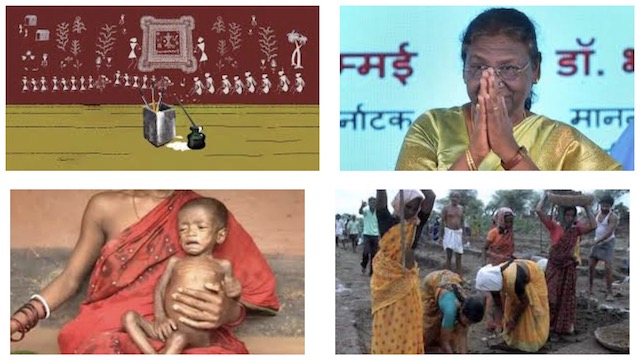Amarendra Das and I have visited a set of schools in the tribal villages of the Gajapati district of Odisha state (in India) early this year. Since these tribal communities speak a different language (namely Soura) (and they don’t speak the main language of the state – Oriya), schools here practice bilingual education in 1-4 grades. The use of their own language in school has encouraged the students to be more active in classrooms and reduced their fear of schooling. However, there are a number of issues: There are not enough teachers who know both languages. […]
Higher education and teacher-training specifically aimed at such social groups can play an important role here. This can be an agenda for Azim Premji University and others, which are interested in contributing to the `quality schooling for all’ and social change in India.
Source: Schooling of Scheduled Tribes in India: Lessons from the indigenous people of Brazil – Economics in action
Address : https://vsanthakumar.wordpress.com/2017/07/03/schooling-of-scheduled-tribes-in-india-lessons-from-the-indigenous-people-of-brazil/
Date Visited: 23 September 2023
V Santhakumar, a Professor at Azim Premji University, writes on contemporary or real world issues with a lens of economics or social sciences. He teaches economics for development practitioners in the university, and carries out research on education and development issues. […]
While working as a civil engineer on a non-governmental initiative to plan watershed management in a village in Kerala in the late eighties, Santhakumar felt the need for a social science education. That led him to pursue Masters and Doctoral degrees in social science (IIT Chennai) followed by post-doctoral fellowships at the Wageningen Agricultural University (Netherlands) and Vanderbilt University (USA). He has been on the faculty of the Centre for Development Studies (Trivandrum) from 1996. He has used neoclassical economics (and broadly the rational choice approach) in analyzing and designing institutions and mechanisms of governance. He has also worked on the economics of conserving environment and natural resources. However, his current interest is on the inter-linkages between development and education, and the ways of shortening the `distance’ between population groups so as to mitigate the `development differences’ between them. […]
Source: University and Azim Premji Foundation | Azim Premji University
Address: https://azimpremjiuniversity.edu.in/SitePages/v-santhakumar.aspx
Date Visited: Mon Jul 10 2017 16:35:37 GMT+0200 (CEST)
Whilst its clear that education is a vital need of children everywhere, schooling – as experienced by many tribal children – can be more of a curse than a blessing. It is frequently used as a tool to separate indigenous children from their families, traditions and languages and helps the state to gain control over tribal peoples and their lands. It does not have to be this way: appropriate tribal schooling exists – it is just far too rare.
Source: Schooling and Tribal children
Address: https://www.survivalinternational.org/about/schooling
Date Visited: Mon Jul 10 2017 16:31:41 GMT+0200 (CEST)
Brazil project aims to save endangered indigenous languages
To read the full article, click here >>
Of the estimated 2,000 indigenous languages thought to have been spoken in pre-Columbian times in what is now Brazil, only around 160 survive today. Experts warn that as many as 40 percent of those remaining could be lost in the next few decades, as elders die off and young people get more access to television, the Internet and cellphones. […]
A program spearheaded in part by UNESCO, the UN’s cultural and educational agency, aims to give a fighting chance to nearly three dozen threatened languages. Over nearly eight years, the program has helped 35 tribes to transcribe their languages, develop dictionaries and teaching tools for children and document their rich oral traditions.
“We used to learn our language and the stories of our people with our elders,” said Elly Mairu Karaja, of the Karaja people of central Brazil, a schoolteacher who’s worked with the program. “But now, with technology, the youngsters are living in the white world even while they’re on our land. There are many now who don’t want to be indigenous anymore.” […]
The indigenous population is splintered into 305 tribes, some with just several dozen or fewer members. […]
“In Brazil, nearly 40 percent of indigenous nations have fewer than 500 members,” said Levinho. “Studies have shown that these days, such small populations aren’t able preserve their languages.”
“We have several peoples who’ve completely lost their languages and want to try to recover them; we have some peoples where there are very few speakers left; some where there are generational conflicts; and some where the indigenous language has become the second language,” he added. […]
Source: Brazil project aims to save endangered indigenous languages | Inquirer lifestyle
Address: https://lifestyle.inquirer.net/212476/brazil-project-aims-to-save-endangered-indigenous-languages/
Date Visited: Mon Jul 10 2017 16:36:55 GMT+0200 (CEST)
[Bold typeface added above for emphasis]

linked to each other.” – Droupadi Murmu | Speeches by the President of India >>
Images © publishers, artists & photographers featured by Google Safe Search
Learn more about water-related issues that affect India’s tribal communities >>
“Together, we must endeavour to strengthen tribal communities which are the role model in preservation of water, forest and land, and learn from their connection with nature and the surrounding environment for the sake of the entire human race.” – journalist and tribal rights activist Dayamani Barla in The Wire >>